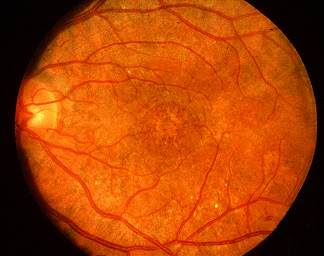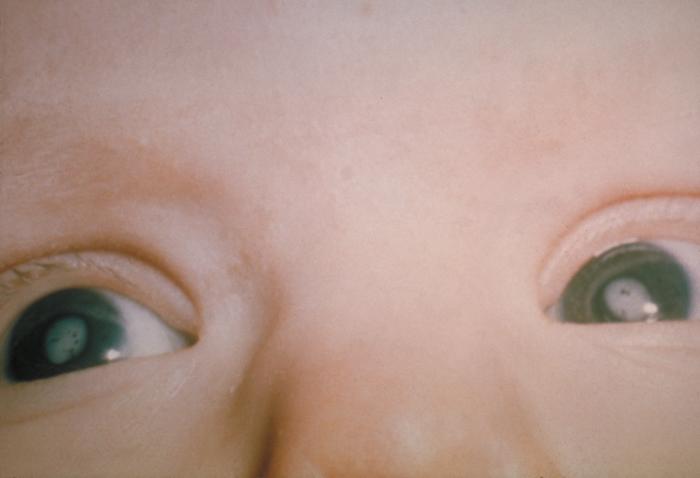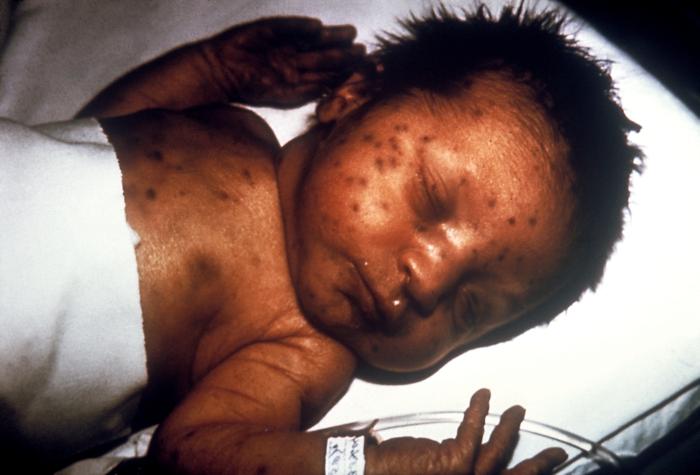Congenital rubella syndrome pathophysiology: Difference between revisions
Dima Nimri (talk | contribs) |
Dima Nimri (talk | contribs) |
||
| Line 8: | Line 8: | ||
==Pathophysiology== | ==Pathophysiology== | ||
===Pathogenesis=== | ===Pathogenesis=== | ||
The pathogenesis of congenital rubella syndrome is believed to be multifactorial. In an attempt to explain the pathogenesis, the following must be noted:<ref name="pmid16580940">{{cite journal |vauthors=De Santis M, Cavaliere AF, Straface G, Caruso A |title=Rubella infection in pregnancy |journal=Reprod. Toxicol. |volume=21 |issue=4 |pages=390–8 |year=2006 |pmid=16580940 |doi=10.1016/j.reprotox.2005.01.014 |url=}}</ref><ref name="pmid25576992">{{cite journal |vauthors=Lambert N, Strebel P, Orenstein W, Icenogle J, Poland GA |title=Rubella |journal=Lancet |volume=385 |issue=9984 |pages=2297–307 |year=2015 |pmid=25576992 |pmc=4514442 |doi=10.1016/S0140-6736(14)60539-0 |url=}}</ref><ref name="pmid25066688">{{cite journal |vauthors=Bouthry E, Picone O, Hamdi G, Grangeot-Keros L, Ayoubi JM, Vauloup-Fellous C |title=Rubella and pregnancy: diagnosis, management and outcomes |journal=Prenat. Diagn. |volume=34 |issue=13 |pages=1246–53 |year=2014 |pmid=25066688 |doi=10.1002/pd.4467 |url=}}</ref><ref name="pmid11023958">{{cite journal |vauthors=Lee JY, Bowden DS |title=Rubella virus replication and links to teratogenicity |journal=Clin. Microbiol. Rev. |volume=13 |issue=4 |pages=571–87 |year=2000 |pmid=11023958 |pmc=88950 |doi= |url=}}</ref><ref name="pmid17920097">{{cite journal |vauthors=Adamo MP, Zapata M, Frey TK |title=Analysis of gene expression in fetal and adult cells infected with rubella virus |journal=Virology |volume=370 |issue=1 |pages=1–11 |year=2008 |pmid=17920097 |pmc=2694049 |doi=10.1016/j.virol.2007.08.003 |url=}}</ref> | |||
*[[Pregnant]] women who are not vaccinated against [[rubella virus]] are at a risk of contracting the [[infection]]. It must be noted however, that not every [[pregnant]] woman's infection results in [[vertical transmission]] to her [[fetus]]. In addition, not every [[fetus]] infected with [[rubella virus]] has fetal abnormalities or CRS. The typical clinical course of CRS usually begins with a [[pregnant]] woman being exposed to the [[virus]] via the [[respiratory]] route. The [[virus]] then infects the [[placenta]] and spreads to the [[fetus]]. This results in [[systemic]] [[inflammation]] in the fetus and multiple [[fetal]] [[anomalies]], due to disruption of [[organogenesis]]. | *[[Pregnant]] women who are not vaccinated against [[rubella virus]] are at a risk of contracting the [[infection]]. It must be noted however, that not every [[pregnant]] woman's infection results in [[vertical transmission]] to her [[fetus]]. In addition, not every [[fetus]] infected with [[rubella virus]] has fetal abnormalities or CRS. The typical clinical course of CRS usually begins with a [[pregnant]] woman being exposed to the [[virus]] via the [[respiratory]] route. The [[virus]] then infects the [[placenta]] and spreads to the [[fetus]]. This results in [[systemic]] [[inflammation]] in the fetus and multiple [[fetal]] [[anomalies]], due to disruption of [[organogenesis]]. | ||
*The timing of the [[maternal]] [[infection]] has important implications on the [[fetus]]. If the woman is infected just before [[conception]] or during the first 8-10 weeks of [[gestation]], severe [[fetal]] anomalies are most likely to occur, including [[stillbirth]]. However, beyond 16 weeks of [[gestation]], rarely any [[fetal]] defects are associated with maternal [[rubella]] infection. | *The timing of the [[maternal]] [[infection]] has important implications on the [[fetus]]. If the woman is infected just before [[conception]] or during the first 8-10 weeks of [[gestation]], severe [[fetal]] anomalies are most likely to occur, including [[stillbirth]]. However, beyond 16 weeks of [[gestation]], rarely any [[fetal]] defects are associated with maternal [[rubella]] infection. | ||
Revision as of 16:49, 17 January 2017
Editor-In-Chief: C. Michael Gibson, M.S., M.D. [1]; Associate Editor(s)-in-Chief: Dima Nimri, M.D. [2]
|
Congenital Rubella Syndrome Microchapters |
|
Differentiating Congenital Rubella Syndrome from other Diseases |
|
Diagnosis |
|
Treatment |
|
Case Studies |
|
Congenital rubella syndrome pathophysiology On the Web |
|
American Roentgen Ray Society Images of Congenital rubella syndrome pathophysiology |
|
Directions to Hospitals Treating Congenital rubella syndrome |
|
Risk calculators and risk factors for Congenital rubella syndrome pathophysiology |
Overview
Pathophysiology
Pathogenesis
The pathogenesis of congenital rubella syndrome is believed to be multifactorial. In an attempt to explain the pathogenesis, the following must be noted:[1][2][3][4][5]
- Pregnant women who are not vaccinated against rubella virus are at a risk of contracting the infection. It must be noted however, that not every pregnant woman's infection results in vertical transmission to her fetus. In addition, not every fetus infected with rubella virus has fetal abnormalities or CRS. The typical clinical course of CRS usually begins with a pregnant woman being exposed to the virus via the respiratory route. The virus then infects the placenta and spreads to the fetus. This results in systemic inflammation in the fetus and multiple fetal anomalies, due to disruption of organogenesis.
- The timing of the maternal infection has important implications on the fetus. If the woman is infected just before conception or during the first 8-10 weeks of gestation, severe fetal anomalies are most likely to occur, including stillbirth. However, beyond 16 weeks of gestation, rarely any fetal defects are associated with maternal rubella infection.
Gross Pathology
-
"salt and pepper" retinopathy is the most common ocular manifestation of CRS. Adapted from https://commons.wikimedia.org/w/index.php?title=Special:Search&profile=default&fulltext=Search&search=congenital+rubella&uselang=en&searchToken=8w4tgh0h9d3qa8wfbhn0r0z6z#/media/File:Congenital_Rubella_Syndrome,_Salt_and_Pepper_Retinopathy.jpg. Accessed on Jan 16, 2017
-
A child with congenital cataracts as a consequence of CRS. Adapted from https://commons.wikimedia.org/w/index.php?title=Special:Search&profile=default&fulltext=Search&search=congenital+rubella&uselang=en&searchToken=8w4tgh0h9d3qa8wfbhn0r0z6z#/media/File:Cataracts_due_to_Congenital_Rubella_Syndrome_(CRS)_PHIL_4284_lores.jpg. Accessed on Jan 16, 2017
-
"Blueberry muffin" skin lesions, indicative of CRS. Adapted from https://commons.wikimedia.org/w/index.php?title=Special:Search&profile=default&fulltext=Search&search=congenital+rubella&uselang=en&searchToken=8w4tgh0h9d3qa8wfbhn0r0z6z#/media/File:Infant_with_skin_lesions_from_congenital_rubella.jpg. Accessed on Jan 16, 2017
Microscopic Pathology
- Noninflammatory necrosis is seen in the epithelium of the chorion, as well as in the endothelial cells.[3]
- Cell mitosis is inhibited as a result of inhibition of actin assembly.[3]
References
- ↑ De Santis M, Cavaliere AF, Straface G, Caruso A (2006). "Rubella infection in pregnancy". Reprod. Toxicol. 21 (4): 390–8. doi:10.1016/j.reprotox.2005.01.014. PMID 16580940.
- ↑ Lambert N, Strebel P, Orenstein W, Icenogle J, Poland GA (2015). "Rubella". Lancet. 385 (9984): 2297–307. doi:10.1016/S0140-6736(14)60539-0. PMC 4514442. PMID 25576992.
- ↑ 3.0 3.1 3.2 Bouthry E, Picone O, Hamdi G, Grangeot-Keros L, Ayoubi JM, Vauloup-Fellous C (2014). "Rubella and pregnancy: diagnosis, management and outcomes". Prenat. Diagn. 34 (13): 1246–53. doi:10.1002/pd.4467. PMID 25066688.
- ↑ Lee JY, Bowden DS (2000). "Rubella virus replication and links to teratogenicity". Clin. Microbiol. Rev. 13 (4): 571–87. PMC 88950. PMID 11023958.
- ↑ Adamo MP, Zapata M, Frey TK (2008). "Analysis of gene expression in fetal and adult cells infected with rubella virus". Virology. 370 (1): 1–11. doi:10.1016/j.virol.2007.08.003. PMC 2694049. PMID 17920097.


